Research Hotspots and Future Trends in Canal-Related Industrial Buildings
Abstract
:1. Introduction
2. Materials and Methods
2.1. Data Collection
2.2. Research Method
3. Data Result Analysis
3.1. Analysis of Publication Quantity
3.2. Co-Authorship Analysis
3.2.1. Country Co-Authorship Analysis
3.2.2. Institutional Co-Authorship Analysis
3.2.3. Author Co-Authorship Analysis
3.3. Co-Citation Analysis
3.3.1. Journal Co-Citation Analysis
3.3.2. Literature Co-Citation Analysis
3.3.3. Authors Co-Citation Analysis
3.4. Research Hotspot Analysis
3.4.1. Keyword Co-Occurrence Analysis
3.4.2. Keyword Cluster Analysis
4. Research Trends and Future Directions Analysis
4.1. Trends Analysis
4.2. Future Research Trends
5. Conclusions
Author Contributions
Funding
Institutional Review Board Statement
Informed Consent Statement
Data Availability Statement
Conflicts of Interest
References
- Casadei, C. The Inner Areas Italian Question: The Territory of Southern Inner Etruria along the via Clodia. ANUARI D’arquitectura I Soc. 2022, 2, 134–166. [Google Scholar] [CrossRef]
- Cipolla, C.M. Before the Industrial Revolution: European Society and Economy 1000–1700, 3rd ed.; Routledge: London, UK, 2004. [Google Scholar] [CrossRef]
- Principles, D. Joint ICOMOS-TICCIH Principles for the Conservation of Industrial Heritage Sites, Structures, Areas and Landscapes. Adopted by the 17th ICOMOS General Assembly on 28 November 2011. Available online: https://whc.unesco.org/uploads/activities/documents/activity-646-1.pdf (accessed on 5 June 2024).
- Crompton, G.W. Canals and the Industrial Revolution. J. Transp. Hist. 1993, 14, 93–110. [Google Scholar] [CrossRef]
- Maw, P.; Wyke, T.; Kidd, A. Canals, Rivers, and the Industrial City: Manchester’s Industrial Waterfront, 1790–1850. Econ. Hist. Rev. 2012, 65, 1495–1523. [Google Scholar] [CrossRef]
- Cutler, D.M.; Miller, G. Water, Water, Everywhere: Municipal Finance and Water Supply in American Cities 2005. NBER Working Paper No. w11096. Available online: https://ssrn.com/abstract=657621 (accessed on 5 June 2024).
- Maw, P. Transport and the Industrial City: Manchester and the Canal Age, 1750–1850. In Transport and the Industrial City; Manchester University Press: Manchester, UK, 2018; pp. 1–320. [Google Scholar]
- High, S. Industrial Sunset: The Making of North America’s Rust Belt, 1969–1984; University of Toronto Press: Toronto, ON, Canada, 2003. [Google Scholar]
- Tognon, A.; Bovati, M. Between Abandonment and Resilient Thrusts in the Mountain Territories of the Orobie (Bergamo). ANUARI D’arquitectura I Soc. 2022, 86–110. [Google Scholar] [CrossRef]
- De Andrés, I.C.S.M.; i Fausto, I.C. El Frontón Beti Jai de Madrid y Su Estructura. Tecnol. Diseño Innov. 2021, 7, 18–30. [Google Scholar]
- Curulli, G.I.; Koolen, G.A. Heritage and Management in the Transformation of Industrial Canal Zones: The Case of B5 in The Netherlands. In Conference; FM in the Experience Economy; 2010-09-13; 2010-09-15; International Council for Research and Innovation in Building and Construction: Ottawa, ON, Canada, 2010; pp. 495–509. [Google Scholar]
- Hay, D. Preserving Industrial Heritage: Challenges, Options, and Priorities. Forum J. 2011, 25, 11–24. [Google Scholar]
- Ržepicka, D.; Ziemeļniece, A. Context of Trade Canal and Industrial Heritage in Liepaja. In Proceedings of the International Scientific and Practical Conference, Lisbon, Portugal, 15 June 2017; pp. 253–258. [Google Scholar]
- Pallasmaa, J. Existential Homelessness. Placeless and Nostalgia in the Age of Mobility. ANUARI D’arquitectura I Soc. 2023, 16–43. [Google Scholar] [CrossRef]
- i Fausto, I.C.; Forner, E.F.; Lanzarote, B.S. The New Entrance to the Camí d’Onda Air-Raid Shelter in the Historic Center of Borriana, Spain. TECHNE—J. Technol. Archit. Environ. 2020, 19, 290–297. [Google Scholar] [CrossRef]
- Abad, C.J.P.; Portela, J.F. The Castilla Canal: Water Heritage Resource and Prospects for Use and Tourism Innovation. Cuad. Tur. 2022, 50, 435–439. [Google Scholar] [CrossRef]
- Boyack, K.W.; Klavans, R.; Börner, K. Mapping the Backbone of Science. Scientometrics 2005, 64, 351–374. [Google Scholar] [CrossRef]
- Chen, X.; Liu, Y. Visualization Analysis of High-Speed Railway Research Based on CiteSpace. Transp. Policy 2020, 85, 1–17. [Google Scholar] [CrossRef]
- Ding, X.; Yang, Z. Knowledge Mapping of Platform Research: A Visual Analysis Using VOSviewer and CiteSpace. Electron. Commer. Res. 2020, 22, 787–809. [Google Scholar] [CrossRef]
- Moed, H.F.; Glänzel, W.; Schmoch, U. (Eds.) Handbook of Quantitative Science and Technology Research: The Use of Publication and Patent Statistics in Studies of S&T Systems; Springer: Dordrecht, The Netherlands, 2005; ISBN 978-1-4020-2702-4. [Google Scholar]
- Han, P.; Shi, J.; Li, X.; Wang, D.; Shen, S.; Su, X. International Collaboration in LIS: Global Trends and Networks at the Country and Institution Level. Scientometrics 2014, 98, 53–72. [Google Scholar] [CrossRef]
- Melin, G.; Persson, O. Studying Research Collaboration Using Co-Authorships. Scientometrics 1996, 36, 363–377. [Google Scholar] [CrossRef]
- Pan, R.K.; Kaski, K.; Fortunato, S. World Citation and Collaboration Networks: Uncovering the Role of Geography in Science. Sci. Rep. 2012, 2, 902. [Google Scholar] [CrossRef]
- Cai, J.; Peng, J. Introduction of Beijing-Hangzhou Grand Canal and Analysis of Its Heritage Values. J. Hydro-Environ. Res. 2019, 26, 2–7. [Google Scholar] [CrossRef]
- Goula, M.; Vanucchi, J. Sustained Change: Design Speculations on the Performance of Fallow-Scapes in Time along the Erie Canal National Heritage Corridor, (ECNHC), New York. Sustainability 2022, 14, 1675. [Google Scholar] [CrossRef]
- Douglas, I.; Hodgson, R.; Lawson, N. Industry, Environment and Health through 200 Years in Manchester. Ecol. Econ. 2002, 41, 235–255. [Google Scholar] [CrossRef]
- Danzer, G.A. The Illinois & Michigan Canal National Heritage Corridor: A Guide to Its History and Sources 1989. Available online: https://scholarworks.iu.edu/journals/index.php/imh/article/view/11019 (accessed on 5 June 2024).
- UNESCO. Information Document on Heritage Canals; UNESCO: Paris, France, 1994; Available online: https://whc.unesco.org/archive/canals94.htm (accessed on 5 June 2024).
- Canal & River Trust. Greater Manchester Canals Heritage Partnership Agreement; Canal & River Trust: Birmingham, UK, 2014; Available online: https://canalrivertrust.org.uk/media/original/22929-heritage-report-2015.pdf (accessed on 5 June 2024).
- Li, Y.; Zheng, N. Integral Protection of Cultural Heritage of the Grand Canal of China: A Perspective of Cultural Spaces. Front. Soc. Sci. Technol. 2020, 2, 60–69. [Google Scholar]
- China Social Division. 14th Five-Year Plan” for the Protection, Inheritance and Utilisation of the Grand Canal Culture; China Social Division: Beijing, China, 2021. Available online: http://www.gov.cn/zhengce/2022-08/16/content_5705612.htm (accessed on 5 June 2024).
- D’Agostino, M.; Medas, S. Roman Navigation in Venice Lagoon: The Results of Underwater Research. Int. J. Naut. Archaeol. 2010, 39, 286–294. [Google Scholar] [CrossRef]
- Berto, L.; Talledo, D.A.; Bruschi, G.; Zamboni, I.; Lazzarini, E.; Zofrea, C.; Faccio, P.; Saetta, A. A Multidisciplinary Approach for the Vulnerability Assessment of a Venetian Historic Palace: High Water Phenomena and Climate Change Effects. Buildings 2022, 12, 431. [Google Scholar] [CrossRef]
- Bugini, R.; Folli, L. Stones Used in Milan Architecture. Mater. Constr. 2008, 58, 33–50. [Google Scholar]
- Ye, Z.-L.; Lin, X.; Xu, Y.; Pan, S.; Wu, J. Domestic Waste Disposal Planning for the Xianghe Segment of China’s Grand Canal. Int. J. Sustain. Dev. World Ecol. 2016, 23, 351–357. [Google Scholar] [CrossRef]
- Rong, Q.; Wang, J. Interpreting Heritage Canals from the Perspective of Historical Events: A Case Study of the Hangzhou Section of the Grand Canal, China. J. Asian Archit. Build. Eng. 2021, 20, 260–271. [Google Scholar] [CrossRef]
- Clarke, L. An Overview of Heritage and Engineering on the Canal System. Proc. Inst. Civ. Eng.-Eng. Hist. Herit. 2015, 168, 93–100. [Google Scholar] [CrossRef]
- Crowe, N. The Rolt Memorial Lecture 2017: Conserving the Waterways Heritage. Ind. Archaeol. Rev. 2018, 40, 65–73. [Google Scholar] [CrossRef]
- Ruiz, R.; Cruz, L.; Rodríguez, F.J.; Coronado, J.M. Civil Engineering Heritage in Spain: Public Protection Strategies. Proc. Inst. Civ. Eng.-Eng. Hist. Herit. 2016, 169, 84–94. [Google Scholar] [CrossRef]
- Ruiz, R.; Rodríguez, J.; Coronado, J.M. Modern Roads as UNESCO World Heritage Sites: Framework and Proposals. Int. J. Herit. Stud. 2017, 23, 362–374. [Google Scholar] [CrossRef]
- Ghennaï, A.; Madani, S.; Hein, C. Prospective of an Inland Waterway System of Shipping Canals in Skikda (Algeria). Urban Plan. 2023, 8, 376–389. [Google Scholar] [CrossRef]
- Zhao, Y.; Yan, J.; Huang, M.; Bian, G.; Du, Y. Analysis of Settlement Space Environment along China’s Grand Canal Tianjin Section Based on Structural Equation Model-Case Study of 44 Typical Settlements. Sustainability 2022, 14, 5369. [Google Scholar] [CrossRef]
- López-Bravo, C.; López, J.P. Learning from Medieval Italy: Urban Sustainability Concepts from the Heritage of Hydraulic Infrastructures. The Cases of Venice, Siena and Bologna. J. Cult. Herit. Manag. Sustain. Dev. 2024; ahead-of-print. [Google Scholar] [CrossRef]
- Rossi, M. Learning from the Past: Water Heritage. Landscape Patterns Around Parma. In Putting Tradition into Practice: Heritage, Place and Design; Amoruso, G., Ed.; Lecture Notes in Civil Engineering; Springer International Publishing: Cham, Switzerland, 2018; Volume 3, pp. 1001–1009. ISBN 978-3-319-57936-8. [Google Scholar]
- Williams, A.E.; Waterfall, R.J.; White, K.N.; Hendry, K. Manchester Ship Canal and Salford Quays: Industrial Legacy and Ecological Restoration. In Ecological Reviews: Ecology of Industrial Pollution; Cambridge University Press: Cambridge, UK, 2010; pp. 276–308. [Google Scholar] [CrossRef]
- Franceschet, M. Collaboration in Computer Science: A Network Science Approach. J. Am. Soc. Inf. Sci. Technol. 2011, 62, 1992–2012. [Google Scholar] [CrossRef]
- Biscaro, C.; Giupponi, C. Co-Authorship and Bibliographic Coupling Network Effects on Citations. PLoS ONE 2014, 9, e99502. [Google Scholar] [CrossRef]
- Nerur, S.P.; Rasheed, A.A.; Natarajan, V. The Intellectual Structure of the Strategic Management Field: An Author Co-citation Analysis. Strateg. Manag. J. 2008, 29, 319–336. [Google Scholar] [CrossRef]
- McDonald, J.D. Understanding Journal Usage: A Statistical Analysis of Citation and Use. J. Am. Soc. Inf. Sci. Technol. 2007, 58, 39–50. [Google Scholar] [CrossRef]
- González-Teruel, A.; González-Alcaide, G.; Barrios, M.; Abad-García, M.-F. Mapping Recent Information Behavior Research: An Analysis of Co-Authorship and Co-Citation Networks. Scientometrics 2015, 103, 687–705. [Google Scholar] [CrossRef]
- Chen, C. Mapping Scientific Frontiers: The Quest for Knowledge Visualization; Springer: London, UK, 2013; ISBN 978-1-4471-5127-2. [Google Scholar]
- Li, H. Conservation of Heritage Corridor—Case Study of Historic Towns in Beijing-Tianjin Section of the Grand Canal. In Proceedings of the Advanced Building Materials and Sustainable Architecture, PTS 1–4, Yantai, China, 25–27 May 2012; Shao, Y., Hao, S., Luo, Y., Xing, J., Liu, Z., Eds.; Trans Tech Publications Ltd.: Stafa-Zurich, Switzerland, 2012; Volume 174–177, pp. 3633–3639. [Google Scholar]
- Raitz, K.; O’Malley, N. Kentucky’s Frontier Highway: Historical Landscapes along the Maysville Road; University Press of Kentucky: Lexington, KY, USA, 2012. [Google Scholar]
- Ruiz, R.; Moyano, A.; Romero De Ávila, V.; Coronado, J.M.; Rodríguez, J. Heritage Preservation Training in Civil Engineering Education: Modern Roads Restoration Projects. J. Prof. Issues Eng. Educ. Pract. 2018, 144, 05018008. [Google Scholar] [CrossRef]
- Ruiz, R.; Rodríguez, F.J.; Coronado, J.M. Identification and Assessment of Engineered Road Heritage: A Methodological Approach. J. Cult. Herit. 2014, 15, 36–43. [Google Scholar] [CrossRef]
- Williams, T.P. Predicting Changes in Construction Cost Indexes Using Neural Networks. J. Constr. Eng. Manag. 1994, 120, 306–320. [Google Scholar] [CrossRef]
- Mohammadi Arasteh, S.; Shoaei, S.M. An Assessment of the Effects of Excessive Groundwater Abstraction on the Quality of Groundwater Resources of the Zanjan Plain, Iran. Environ. Earth Sci. 2020, 79, 523. [Google Scholar] [CrossRef]
- Balas, C.E.; Ergin, A. A Sensitivity Study for the Second Order Reliability-Based Design Model of Rubble Mound Breakwaters. Coast. Eng. J. 2000, 42, 57–86. [Google Scholar] [CrossRef]
- Alyami, S.H.; Rezgui, Y. Sustainable Building Assessment Tool Development Approach. Sustain. Cities Soc. 2012, 5, 52–62. [Google Scholar] [CrossRef]
- White, H.D.; McCain, K.W. Visualizing a Discipline: An Author Co-Citation Analysis of Information Science, 1972–1995. J. Am. Soc. Inf. Sci. 1998, 49, 327–355. [Google Scholar] [CrossRef]
- Bu, Y.; Wang, B.; Chinchilla-Rodríguez, Z.; Sugimoto, C.R.; Huang, Y.; Huang, W. Considering Author Sequence in All-Author Co-Citation Analysis. Inf. Process. Manag. 2020, 57, 102300. [Google Scholar] [CrossRef]
- International Council on Monuments and Site (ICOMOS). The Venice Charter; ICOMOS: London, UK, 1964. [Google Scholar]
- International Council on Monuments and Site (ICOMOS). Amsterdam Declaration. In Proceedings of the Congress on the European Architectural Heritage, Amsterdam, The Netherlands, 21–25 October 1975; ICOMOS: Paris, France, 1975. Available online: https://www.icomos.org.tr/Dosyalar/ICOMOSTR_en0458431001536681780.pdf (accessed on 5 June 2024).
- Florence Charter on Historic Gardens 1982; Rue de la Fédération: Paris, France; Available online: https://www.concernedhistorians.org/content_files/file/et/86.pdf (accessed on 5 June 2024).
- Charter for the Conservation of Historic Towns and Urban Areas; Adopted by ICOMOS General Assembly; International Council on Monuments and Site (ICOMOS): Paris, France, 1987; Available online: https://www.icomos.org/images/DOCUMENTS/Charters/towns_e.pdf (accessed on 5 June 2024).
- The Burra Charter: The Australia ICOMOS Charter for Places of Cultural Significance; International Council on Monuments and Site (ICOMOS): Paris, France, 1999; Available online: https://fremantleprison.com.au/media/1496/fremantle-prison-cmp-feb-2010-appendices-a-e.pdf (accessed on 5 June 2024).
- Dotsika, F.; Watkins, A. Identifying Potentially Disruptive Trends by Means of Keyword Network Analysis. Technol. Forecast. Soc. Change 2017, 119, 114–127. [Google Scholar] [CrossRef]
- Lee, P.-C.; Su, H.-N. Investigating the Structure of Regional Innovation System Research through Keyword Co-Occurrence and Social Network Analysis. Innovation 2010, 12, 26–40. [Google Scholar] [CrossRef]
- Cheng, F.-F.; Huang, Y.-W.; Yu, H.-C.; Wu, C.-S. Mapping Knowledge Structure by Keyword Co-Occurrence and Social Network Analysis: Evidence from Library Hi Tech between 2006 and 2017. Libr. Hi Tech. 2018, 36, 636–650. [Google Scholar] [CrossRef]
- Swensen, G.; Nomeikaite, L. Museums as Narrators: Heritage Trails in a Digital Era. J. Herit. Tour. 2019, 14, 525–543. [Google Scholar] [CrossRef]
- Comino, E.; Dominici, L.; Ambrogio, F.; Rosso, M. Mini-Hydro Power Plant for the Improvement of Urban Water-Energy Nexus toward Sustainability-A Case Study. J. Clean. Prod. 2020, 249, 119416. [Google Scholar] [CrossRef]
- Elsorady, D.A. Adaptive Reuse Decision Making of a Heritage Building Antoniadis Palace, Egypt. Int. J. Archit. Herit. 2020, 14, 658–677. [Google Scholar] [CrossRef]
- Charter, N.T. The Nızhny Tagıl Charter for the Industrıal Herıtage; Web adresinden; TICCIH (The International Committee for the Conservation of the Industrial Heritage): Kiruna, Sweden, 2003; Volume 28. [Google Scholar]
- Berger, S.; High, S. (De-) Industrial Heritage: An Introduction. Labor 2019, 16, 1–27. [Google Scholar] [CrossRef]
- Martín Roda, E.M.; Fernández Portela, J. Recovery of Industrial and Natural Heritage as a Resource for Developing Tourism in the Castille Canal Municipalities. Cuad. Tur. 2023, 51, 255–279. [Google Scholar] [CrossRef]
- Madani, F. ‘Technology Mining’Bibliometrics Analysis: Applying Network Analysis and Cluster Analysis. Scientometrics 2015, 105, 323–335. [Google Scholar] [CrossRef]
- Buckman, S. The Development Feasibility of Canal Oriented Development in the Arid Southwest: Opinions of Key Stakeholders. Land Use Policy 2014, 39, 342–349. [Google Scholar] [CrossRef]
- Hong, Y.; Chen, F. Evaluating the Adaptive Reuse Potential of Buildings in Conservation Areas. Facilities 2017, 35, 202–219. [Google Scholar] [CrossRef]
- Hijdra, A.; Arts, J.; Woltjer, J. Do We Need to Rethink Our Waterways? Values of Ageing Waterways in Current and Future Society. Water Resour. Manag. 2014, 28, 2599–2613. [Google Scholar] [CrossRef]
- Labib, S.M. Investigation of the Likelihood of Green Infrastructure (GI) Enhancement along Linear Waterways or on Derelict Sites (DS) Using Machine Learning. Environ. Model. Softw. 2019, 118, 146–165. [Google Scholar] [CrossRef]
- Taraszkiewicz, K.; Nyka, L. Role of Sports Facilities in the Process of Revitalization of Brownfields. In IOP Conference Series: Materials Science and Engineering; IoP Publishing Ltd.: Bristol, UK, 2017; Volume 245, p. 042063. [Google Scholar]
- Wei, T.; Tang, S.; Zhu, W. Research of Green Reconstruction of Hangzhou Arts & Crafts Museum. In Architecture and Urban Development; Zhang, Z.H., Li, Y.J., Eds.; Trans Tech Publications Ltd.: Durnten-Zurich, Switzerland, 2012; Volume 598, p. 106. [Google Scholar] [CrossRef]
- Florenzano, M.; Courel, M.-F.; De Domenico, F. Digitally Conserving an Endangered Built Heritage in Kashgar, an Oasis City of the Taklimakan. In Water and Sustainability in Arid Regions: Water and Sustainability in Arid Regions; Schneier-Madanes, G., Courel, M.-F., Eds.; Springer: Berlin/Heidelberg, Germany, 2010; p. 165. [Google Scholar]
- Wincott, A.; Ravenscroft, N.; Gilchrist, P. Roses and Castles: Competing Visions of Canal Heritage and the Making of Place. Int. J. Herit. Stud. 2020, 26, 737–752. [Google Scholar] [CrossRef]
- Zhu, Q. Industrial Heritage Conservation in Urban Transformation for Sustainable Development. In Proceedings of the 3rd International Conference on Advances in Energy and Environmental Science, Zhuhai, China, 25–26 July 2015; Yarlagadda, P., Ed.; Atlantis Press: Paris, France, 2015; Volume 31, pp. 73–80. [Google Scholar]
- Somayya, M.; Ramaswamy, R. Amsterdam Smart City (ASC): Fishing Village to Sustainable City. In Sustainable City XI; Wit Press: Southampton, UK, 2016; Volume 204, pp. 831–842. [Google Scholar]
- Cabau, B.; Hernandez-Lamas, P.; Woltjer, J. Regent’s Canal Cityscape: From Hidden Waterway to Identifying Landmark. Lond. J. 2022, 47, 282–307. [Google Scholar] [CrossRef]
- Gatta, G.; Bitelli, G. A HGIS for the Study of Waterways: The Case of Bologna as Ancient City of Waters. In IOP Conference Series: Materials Science and Engineering; IoP Publishing Ltd.: Bristol, UK, 2020; Volume 949, p. 012051. [Google Scholar]
- Keats, L.R. The Lowell National Historic Park-Birthplace of the American Industrial Revolution. In Engineering History and Heritage; Rogers, J.R., Ed.; Amer Soc Civil Engineers: New York, NY, USA, 1998; pp. 21–23. [Google Scholar]
- Zhou, W.; Chen, J.; Huang, Y. Co-Citation Analysis and Burst Detection on Financial Bubbles with Scientometrics Approach. Econ. Res.-Ekon. Istraživanja 2019, 32, 2310–2328. [Google Scholar] [CrossRef]
- Moed, H.F. Citation Analysis in Research Evaluation; Springer Science & Business Media: Berlin/Heidelberg, Germany, 2006; Volume 9. [Google Scholar]
- Wang, W.; Lu, C. Visualization Analysis of Big Data Research Based on Citespace. Soft Comput. 2020, 24, 8173–8186. [Google Scholar] [CrossRef]
- Gouws, C. Historical Evidence of Water Management in the Vredefort Dome. S. Afr. J. Cult. Hist. 2016, 30, 21–41. [Google Scholar]
- Yao, D.; Dai, D.S.; Tang, Y.Z.; Zhu, G.Y.; Chen, X. Discussion and Reflection on Several Core Issues in T Grand Canal Heritage Conservation Planning Under the Background of Application for World Heritage. In International Archives of the Photogrammetry, Remote Sensing and Spatial Information Sciences; Copernicus Gesellschaft Mbh: Gottingen, Germany, 2015; Volume XL-5/W7, pp. 471–474. [Google Scholar]
- Addis, B.; Miller, J. Civil Engineering Heritage: Country Profile-England. Proc. Inst. Civ. Eng.-Eng. Hist. Herit. 2017, 170, 80–86. [Google Scholar] [CrossRef]
- Espion, B.; Engels, R.; Provost, M. Civil Engineering Heritage: Country Profile-Belgium. Proc. Inst. Civ. Eng.-Eng. Hist. Herit. 2017, 170, 197–205. [Google Scholar] [CrossRef]
- Damir, M.; Meyer, M.; Aziz, H. Patterns of Detachment: Spatial Transformations of the Phosphate Industry in El-Quseir, Egypt. Urban Plan. 2023, 8, 67–82. [Google Scholar] [CrossRef]
- Matthews, R.; Buckle, R.; Govier, L. Lead Houses: White Lead Processing at the Chester Leadworks. Ind. Archaeol. Rev. 2023, 45, 113–124. [Google Scholar] [CrossRef]
- Barry, R.; Teron, L. Visualising Heritage: A Critical Discourse Analysis of Place, Race, and Nationhood along the Erie Canal. Local Environ. 2023, 28, 739–752. [Google Scholar] [CrossRef]
- Attarian, K.; Safar Ali Najar, B. Heritage Documentation and Structural Analysis of Historic Water-Supply Canals. Environ. Earth Sci. 2022, 81, 100. [Google Scholar] [CrossRef]
- Ventura, H.; Álvarez, M.D.; Gonzalez-Lopez, L.; Claramunt, J.; Ardanuy, M. Cement Composite Plates Reinforced with Nonwoven Fabrics from Technical Textile Waste Fibres: Mechanical and Environmental Assessment. J. Clean. Prod. 2022, 372, 133652. [Google Scholar] [CrossRef]
- Donnellan, D. Interpreting the Galway Hooker: Ecomuseology, Living Heritage and Sustainable Heritage Management. Folk. Life 2023, 61, 121–134. [Google Scholar] [CrossRef]
- Suškevičs, M.; Ehrlich, T.; Peterson, K.; Hiiemäe, O.; Sepp, K. Public Participation in Environmental Assessments in the EU: A Systematic Search and Qualitative Synthesis of Empirical Scientific Literature. Environ. Impact Assess. Rev. 2023, 98, 106944. [Google Scholar] [CrossRef]
- Giddings, B.; Hopwood, B.; O’Brien, G. Environment, Economy and Society: Fitting Them Together into Sustainable Development. Sustain. Dev. 2002, 10, 187–196. [Google Scholar] [CrossRef]
- Nocca, F. The Role of Cultural Heritage in Sustainable Development: Multidimensional Indicators as Decision-Making Tool. Sustainability 2017, 9, 1882. [Google Scholar] [CrossRef]

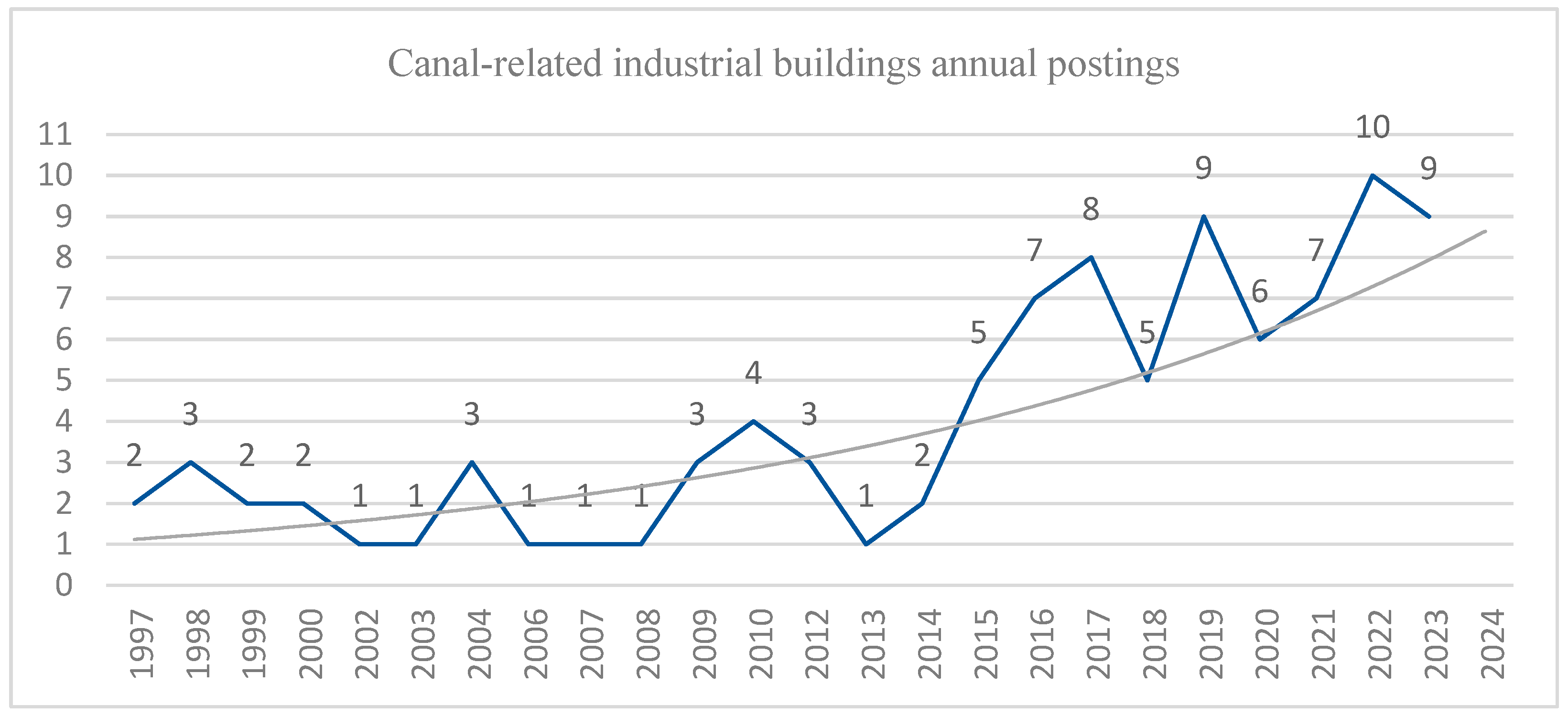

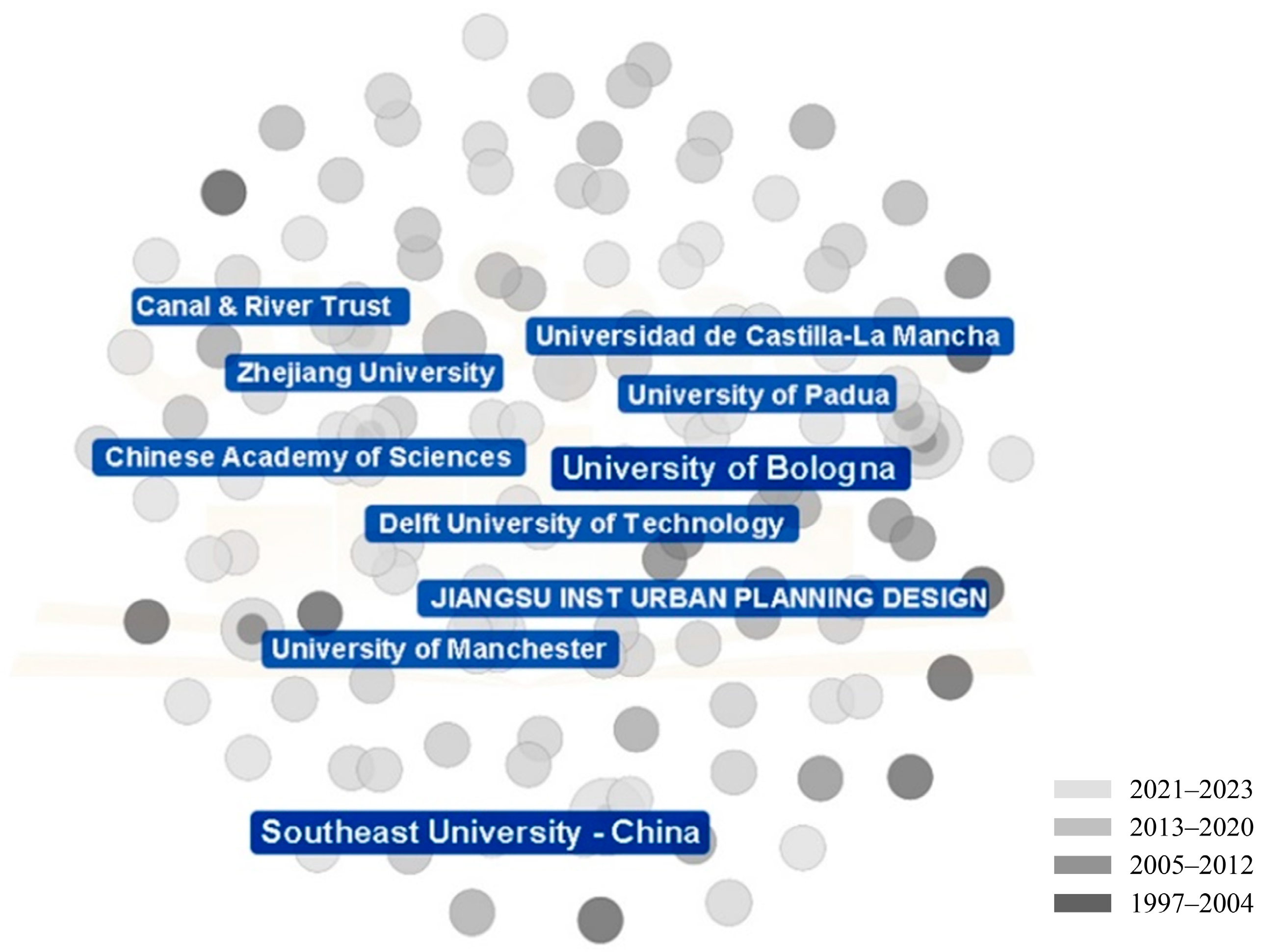
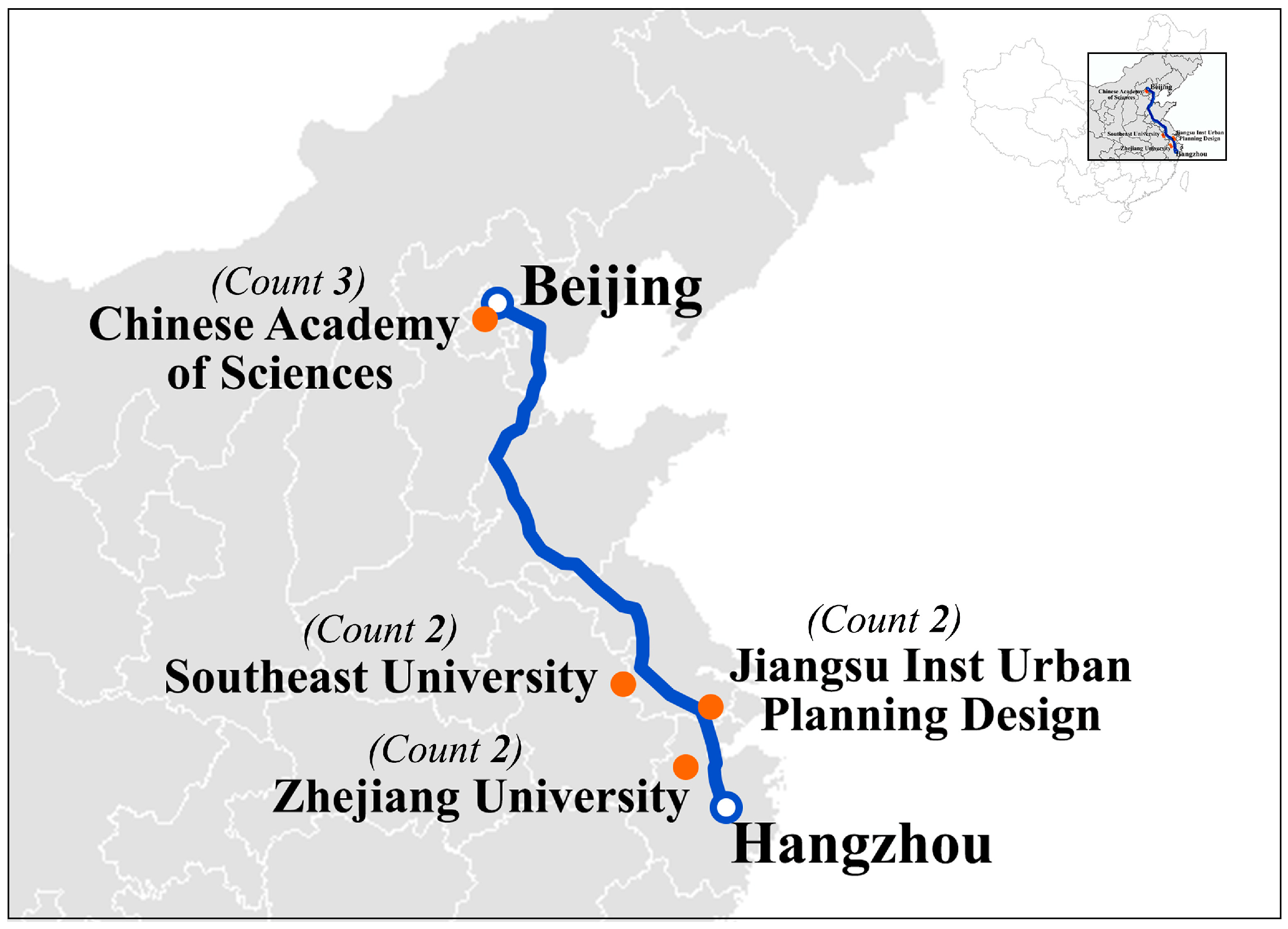

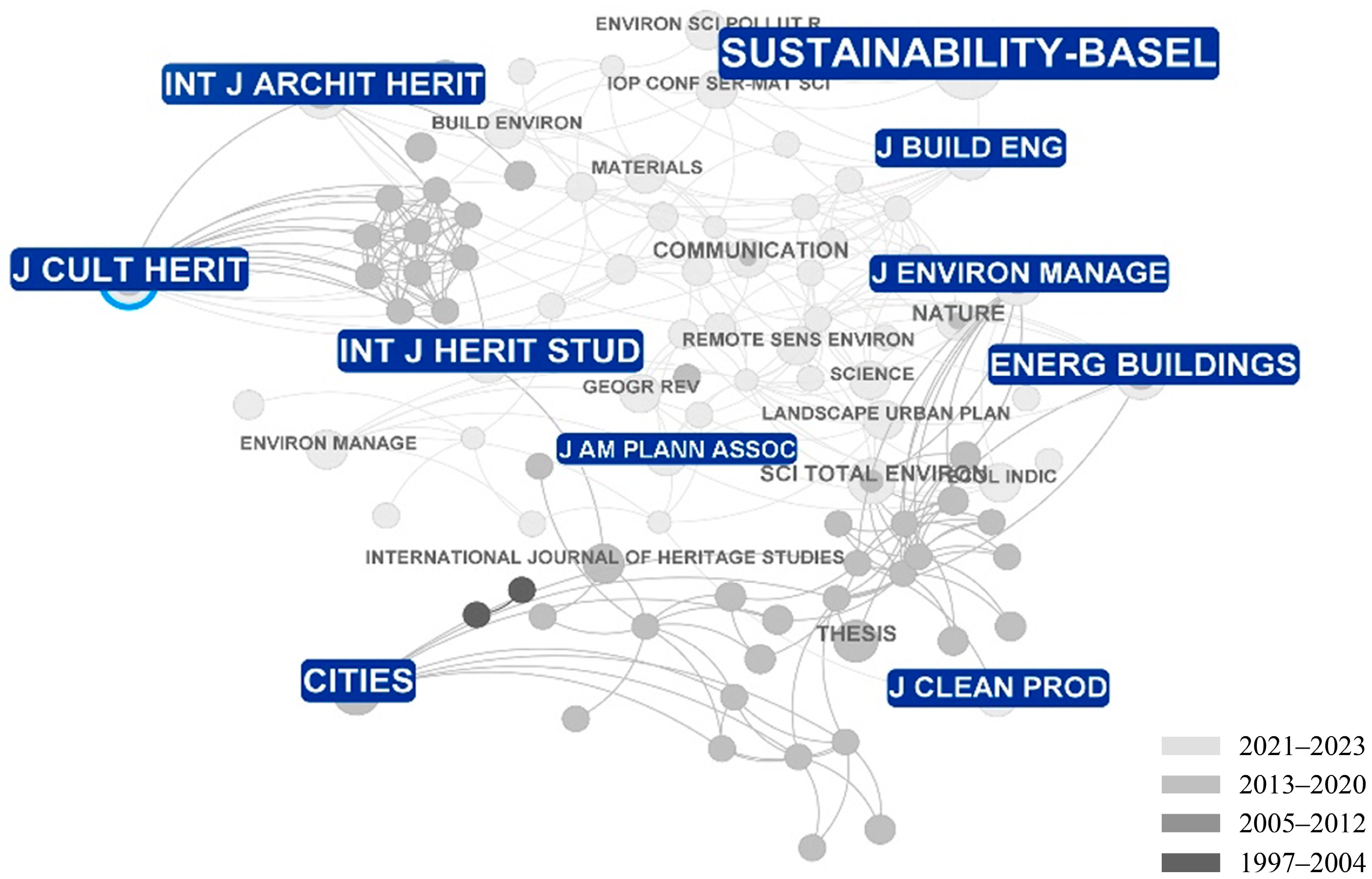

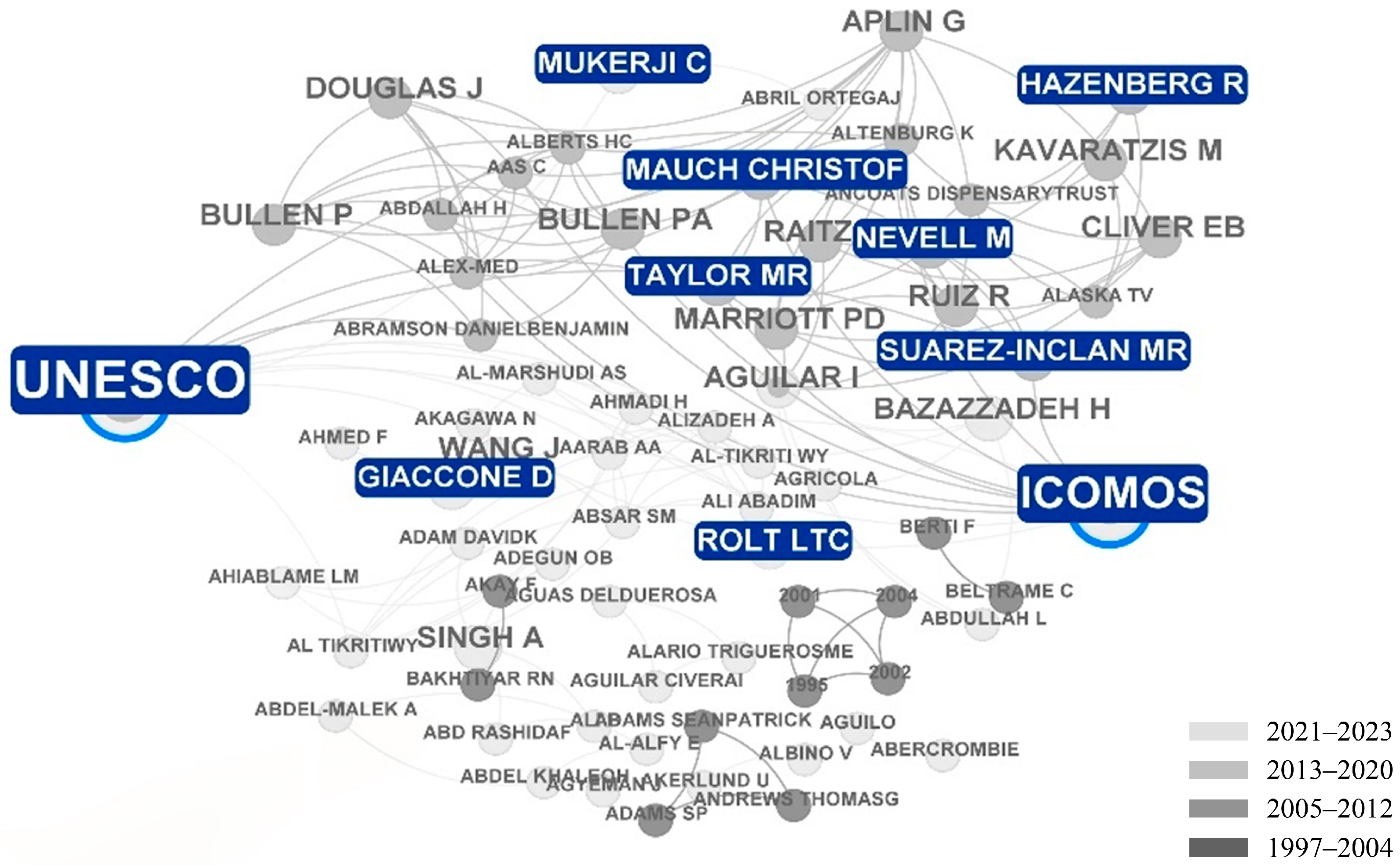
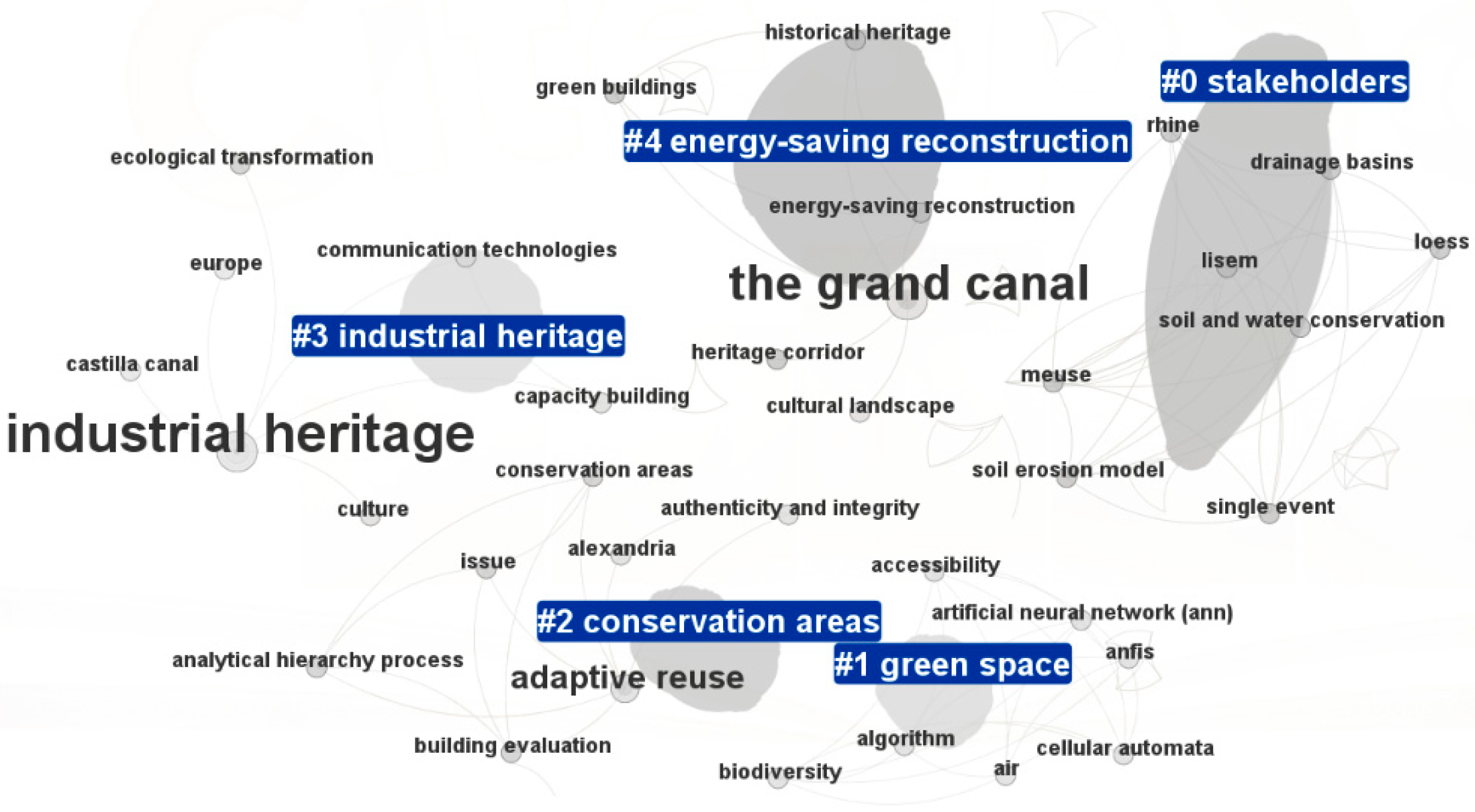
| Counts | Centricity | Year | Country |
|---|---|---|---|
| 17 | 0.34 | 1999 | People’s Republic of China |
| 15 | 0.29 | 2000 | England |
| 15 | 0.26 | 1997 | USA |
| 12 | 0 | 1998 | Italy |
| 8 | 0.17 | 2015 | Spain |
| 5 | 0.06 | 2010 | Netherlands |
| 3 | 0.06 | 1997 | Germany |
| 3 | 0 | 2013 | Poland |
| 3 | 0 | 2009 | Iran |
| 3 | 0 | 2009 | India |
| Counts | Year | Institutions |
|---|---|---|
| 3 | 2003 | University of Bologna |
| 3 | 2015 | Southeast University—China |
| 2 | 2012 | Zhejiang University |
| 2 | 2010 | University of Padua |
| 2 | 2002 | University of Manchester |
| 2 | 2016 | Universidad de Castilla-La Mancha |
| 2 | 2020 | Jiangsu Inst Urban Planning Design |
| 2 | 2022 | Delft University of Technology |
| 2 | 2016 | Chinese Academy of Sciences |
| 2 | 2015 | Canal & River Trust |
| Counts | Year | Institutions |
|---|---|---|
| 2 | 2016 | Ruiz, Rita |
| 2 | 2014 | Woltjer, Johan |
| 1 | 2018 | Zhang, Yiru |
| 1 | 2016 | Kumar, Kalyan |
| 1 | 2021 | Elkadi, H |
| 1 | 2023 | Meng, Bin |
| 1 | 2003 | Macini, P |
| 1 | 2003 | Mesini, E |
| 1 | 2004 | Abdullaev, I |
| 1 | 2021 | Casarin, Filippo |
| Counts | Centricity | Year | Journals |
|---|---|---|---|
| 9 | 0 | 2021 | SUSTAINABILITY-BASEL |
| 6 | 0.03 | 2017 | INT J HERIT STUD |
| 6 | 0.14 | 2016 | J CULT HERIT |
| 6 | 0.11 | 2016 | CITIES |
| 5 | 0.07 | 2017 | ENERG BUILDINGS |
| 5 | 0.05 | 2017 | INT J ARCHIT HERIT |
| 4 | 0.04 | 2014 | J AM PLANN ASSOC |
| 4 | 0.02 | 2019 | J CLEAN PROD |
| 4 | 0.02 | 2019 | J ENVIRON MANAGE |
| 4 | 0.02 | 2022 | J BUILD ENG |
| Counts | Year | Documents |
|---|---|---|
| 2 | 2012 | Raitz K, 2012, KENTUCKYS FRONTIER HIGHWAY: HISTORICAL LANDSCAPES ALONG THE MAYSVILLE ROAD, V0, P1 |
| 2 | 2014 | Ruiz R, 2014, J CULT HERIT, V15, P36, DOI 10.1016/j.culher.2013.01.001 |
| 1 | 1994 | WILLIAMS TP, 1994, J CONSTR ENG M ASCE, V120, P306, DOI 10.1061/(ASCE)0733-9364(1994)120:2(306) |
| 1 | 2020 | Arasteh SM, 2020, ENVIRON EARTH SCI, V79, P0, DOI 10.1007/s12665-020-09268-w |
| 1 | 1996 | NAT PARK SERV, 1996, HDB 140 LOW STOR IND, V0, P0 |
| 1 | 1998 | KPMG, 1998, KPMG PROJ APPR REP E, V0, P0 |
| 1 | 2000 | Balas CE, 2000, COAST ENG J, V42, P57, DOI 10.1142/S0578563400000043 |
| 1 | 2012 | Ajuntament dElx, 2012, PROYECT REH PUEST VA, V0, P0 |
| 1 | 1993 | Warrick RA, 1993, CLIMATE AND SEA LEVEL CHANGE: OBSERVATIONS, V0, P0 |
| 1 | 2015 | Alyami SH, 2015, SUSTAIN SCI, V10, P167, DOI 10.1007/s11625-014-0252-x |
| Frequency | Centrality | Year | Author |
|---|---|---|---|
| 6 | 0.32 | 2016 | UNESCO |
| 4 | 0.11 | 2017 | ICOMOS |
| 2 | 0 | 2017 | MAUCH CHRISTOF |
| 2 | 0.4 | 2016 | SUAREZ-INCLAN MR |
| 2 | 0.01 | 2021 | MENGLANDERJI C |
| 2 | 0.06 | 2016 | NEVELL M |
| 2 | 0.04 | 2016 | TAYLOR MR |
| 2 | 0 | 2016 | HAZENBERG R |
| 2 | 0 | 2022 | GIACCONE D |
| 2 | 0 | 2017 | ROLT LTC |
| Ranking | Counts | Centricity | Year | Keyword |
|---|---|---|---|---|
| 1 | 5 | 0.02 | 2015 | industrial heritage |
| 2 | 4 | 0 | 2012 | the grand canal |
| 3 | 3 | 0.01 | 2004 | water management |
| 4 | 3 | 0 | 2016 | renovation |
| 5 | 2 | 0 | 2019 | design |
| 6 | 2 | 0 | 2016 | Chinas grand canal |
| 7 | 2 | 0.01 | 2012 | heritage |
| 8 | 2 | 0.01 | 2019 | heritage tourism |
| 9 | 2 | 0 | 2017 | adaptive reuse |
| 10 | 2 | 0 | 2015 | heritage management |
| Keywords | Strength | Begin | End | 1997–2023 |
|---|---|---|---|---|
| water management | 0.97 | 2010 | 2017 | ▂▂▂▂▂▂▂▂▂▂▂▂▂▃▃▃▃▃▃▃▃▂▂▂▂▂▂ |
| water history | 1.22 | 2015 | 2016 | ▂▂▂▂▂▂▂▂▂▂▂▂▂▂▂▂▂▂▃▃▃▂▂▂▂▂▂ |
| heritage management | 0.84 | 2015 | 2018 | ▂▂▂▂▂▂▂▂▂▂▂▂▂▂▂▂▂▂▃▃▃▃▂▂▂▂▂ |
| renovation | 1.75 | 2016 | 2017 | ▂▂▂▂▂▂▂▂▂▂▂▂▂▂▂▂▂▂▂▃▃▂▂▂▂▂▂ |
| adaptive reuse | 0.92 | 2017 | 2021 | ▂▂▂▂▂▂▂▂▂▂▂▂▂▂▂▂▂▂▂▂▃▃▃▃▃▂▂ |
| urban regeneration | 0.89 | 2018 | 2023 | ▂▂▂▂▂▂▂▂▂▂▂▂▂▂▂▂▂▂▂▂▂▃▃▃▃▃▃ |
| design | 1.09 | 2019 | 2021 | ▂▂▂▂▂▂▂▂▂▂▂▂▂▂▂▂▂▂▂▂▂▂▃▃▃▂▂ |
| industrial heritage | 1.39 | 2019 | 2023 | ▂▂▂▂▂▂▂▂▂▂▂▂▂▂▂▂▂▂▂▂▂▂▃▃▃▃▃ |
| climate change | 0.79 | 2019 | 2023 | ▂▂▂▂▂▂▂▂▂▂▂▂▂▂▂▂▂▂▂▂▂▂▃▃▃▃▃ |
| heritage tourism | 0.68 | 2019 | 2023 | ▂▂▂▂▂▂▂▂▂▂▂▂▂▂▂▂▂▂▂▂▂▂▃▃▃▃▃ |
Disclaimer/Publisher’s Note: The statements, opinions and data contained in all publications are solely those of the individual author(s) and contributor(s) and not of MDPI and/or the editor(s). MDPI and/or the editor(s) disclaim responsibility for any injury to people or property resulting from any ideas, methods, instructions or products referred to in the content. |
© 2024 by the authors. Licensee MDPI, Basel, Switzerland. This article is an open access article distributed under the terms and conditions of the Creative Commons Attribution (CC BY) license (https://creativecommons.org/licenses/by/4.0/).
Share and Cite
Sun, L.; Fan, X. Research Hotspots and Future Trends in Canal-Related Industrial Buildings. Sustainability 2024, 16, 5208. https://doi.org/10.3390/su16125208
Sun L, Fan X. Research Hotspots and Future Trends in Canal-Related Industrial Buildings. Sustainability. 2024; 16(12):5208. https://doi.org/10.3390/su16125208
Chicago/Turabian StyleSun, Lei, and Xiaoli Fan. 2024. "Research Hotspots and Future Trends in Canal-Related Industrial Buildings" Sustainability 16, no. 12: 5208. https://doi.org/10.3390/su16125208





